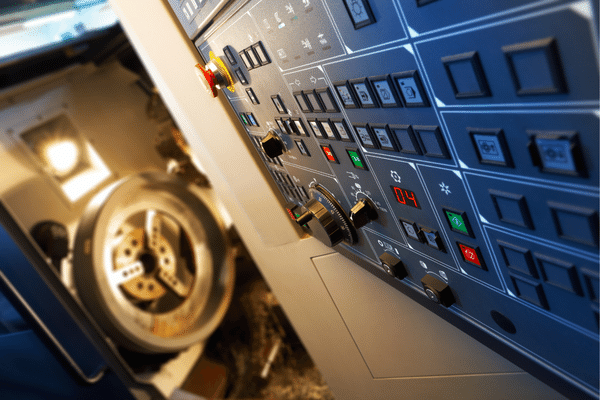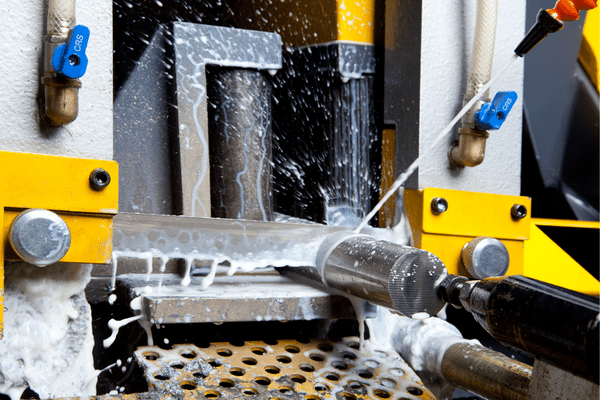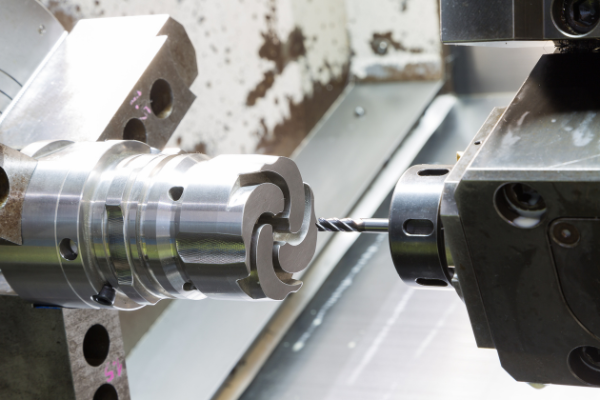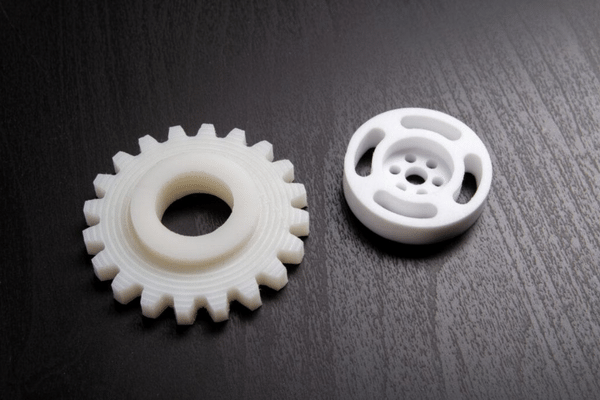How did CNC machines come about, and who invented them?

CNC machining is a process that uses computer numerical control to direct tooling and machinery. The first NC machine was created in the 1940s and has evolved to become more precise and streamlined. Today, CNC machines are used in a variety of industries to manufacture everything from medical devices to aircraft parts.
But how did CNC machines come about? Who invented them? Read on to learn more about the history of CNC machines and the people who helped make them what they are today.
The Evolution of CNC Machines
The first NC machine was created in the 1940s by John T. Parsons, who was working at MIT at the time. Parsons’ machine was able to mill perfectly spherical holes in metal using a three-axis coordinate system. While this was a major accomplishment, the machine was large, expensive, and not very user-friendly.
To make NC machines more accessible, ECA Industries introduced the first commercial NC machine in 1956. This machine was much smaller and more affordable than Parsons’ machine, making it more practical for businesses to invest in. ECA’s machine also used magnetic tape instead of hole punching cards like Parsons’ machine, which made programming the machine much easier.
From there, NC machines continued to evolve and become more sophisticated. In 1963, Numerically Controlled Oscillators (NCOs) were developed, which could be used to create sinusoidal waves with great accuracy. These waves could then control various aspects of the machining process, such as tool path or speed.
In 1977, Yasnac released the world’s first microcomputer-controlled NC machine, which paved the way for even more advances in CNC technology. Today, many different types of CNC machines are available on the market, each with its specific purpose and capabilities. Thanks to continuous innovation, CNC machining has become an essential manufacturing process for businesses all over the world.
Conclusion:
CNC machining is a critical manufacturing process that has evolved since its introduction in the 1940s. Today, many different types of CNC machines are available on the market, each with its specific purpose and capabilities. Thanks to continuous innovation, CNC machining has become an essential manufacturing process for businesses all over the world.
Everything You Need to Know About CNC Machines

CNC machines are computer-controlled tools used to create precision parts and components. These machines can be used for various applications, including milling, drilling, and lathing. This blog post will give you a brief overview of everything you need to know about CNC machines, including how they work and what they’re used for.
How Do CNC Machines Work?
CNC machines are controlled by a computer program that tells the machine what movements to make. The program is typically created using CAM (computer-aided manufacturing) or CAD (computer-aided design) software. Once the program is created, it is loaded onto the CNC machine, carrying out the instructions.
CNC machines are extremely precise and usually create parts and components with tolerances of +/- 0.001 inches or less. This high degree of accuracy is possible because the machines are sequential—meaning they carry out their instructions in a specific order and don’t require manual input from an operator.
What Are CNC Machines Used For?
CNC machines have many uses but are most commonly used for milling, drilling, and lathing. Milling is a machining process that involves removing material from a workpiece with rotating cutting tools. Drilling is another machining process that involves creating holes in a workpiece using rotating cutting tools. Lathing is a machining process that involves shaping a workpiece with rotating cutting tools.
In addition to these common machining processes, CNC machines can be used for other applications such as routing, engraving, plasma cutting, and welding.
Conclusion:
CNC machines are computer-controlled tools used for various applications such as milling, drilling, and lathing. These machines are extremely precise and usually create parts and components with tolerances of +/- 0.001 inches or less. If you need precision parts or components for your business or project, then a CNC machine might be the right tool.
What is CNC Machining?

CNC machining is a process that uses computer numerical control to remove material from a workpiece to create a desired shape or form. This process is sometimes also referred to as “subtractive manufacturing.” It is one of the world’s most widely used manufacturing processes today and is used in various industries, including automotive, aerospace, and medical.
The History of CNC Machining
CNC machining has its roots in NC (numerical control) machining, which was first developed in the 1940s. NC machining was initially used for tooling and die-making applications but quickly began to be used for other manufacturing applications. In the 1950s, NC machines began to be controlled by computers, which resulted in the development of CNC machining.
How Does CNC Machining Work?
CNC machining is performed using a CNC machine consisting of three main components: a controller, an input device, and an output device. The controller is the brain of the operation and is responsible for reading the machining program, interpreting it, and sending out the correct commands to the machine. The input device allows the operator to input the machining program into the machine. The output device is what carries out the machining operations on the workpiece.
Conclusion:
CNC machining is a versatile manufacturing process that can be used to create parts and products for various industries. It is a precise, efficient process that has revolutionized manufacturing over the past few decades. If you need custom parts or products, chances are good that CNC machining can be used to create them.
How to Use a CNC Machine

CNC machines are computer-controlled tools that can make a wide variety of products. To use a CNC machine, you will need to have some basic knowledge of computers and computer-aided design (CAD) software. This guide will walk you through the basics of how to use a CNC machine.
The first thing you need to do is create a design for the product you want to create. This can be done using any CAD software, but it is important to ensure that the design is saved in a format that the CNC machine can read. Once your design is ready, you will need to load it onto the CNC machine.
Once your design is loaded, select the material you want to use. The most common type of material used with CNC machines is wood, but other materials such as metal and plastic can also be used. After you have selected your material, you will need to select the tool you want to use. There are a variety of different tools that can be used with CNC machines, and each one is designed for specific tasks. For example, some tools are designed for cutting while others are designed for drilling.
Once you have selected your tool, you will need to set up the parameters for your job. This includes the depth of the cut and the speed at which the tool should move. After everything is set up, you need to start the machine and let it do its job. Depending on the size and complexity of your job, it may take several hours for the machine to finish.
Conclusion:
CNC machines are amazing tools that can create a wide variety of products. To use a CNC machine, you will need some basic knowledge of computers and CAD software. Once your design is ready, you must load it onto the CNC machine and select the appropriate tool and material. After everything is set up, you need to start the machine and let it do its job. Depending on the size and complexity of your job, it may take several hours for the machine to finish.
The Different Types of Software Used in CNC Machining

If you’re interested in learning about the different types of software used in CNC machining, you’ve come to the right place. In this blog post, we’ll look at two of the most commonly used software programs in CNC machining: Computer Aided Drawing (CAD) and Computer Aided Manufacturing (CAM). We’ll also be discussing the advantages and disadvantages of each type of software.
Computer Aided Drawing (CAD) is a type of software that allows users to create 2D and 3D drawings of objects. CAD is commonly used in the design process of CNC machined parts. CAD drawings can be created using a computer or by hand. The main advantage of using CAD is that it allows for intricate designs to be created quickly and easily. The main disadvantage of CAD is that it can be expensive to purchase the software.
Computer Aided Manufacturing (CAM) helps users generate code for CNC machines. CAM is typically used after a part has been designed using CAD. The advantage of using CAM is that it helps to automate the code generation process. The disadvantage of CAM is that it can be difficult to learn how to use the software.
Conclusion:
In conclusion, two main types of software are used in CNC machining: Computer Aided Drawing (CAD) and Computer Aided Manufacturing (CAM). Both software programs have their advantages and disadvantages. Ultimately, which type of software you use will depend on your specific needs and preferences.
10 Types of CNC Machines You’ll Find in Shops Around the World

CNC machines are computer-controlled machines that can cut or move material as programmed on the controller. The type of cutting can vary from plasma cutting to laser cutting, milling, routing, and lathes. CNC machines can even pick up and move items on an assembly line. So, what are the different types of CNC machines you’ll find in shops worldwide? Let’s take a look.
- CNC Lathe Machine: These machines create cylindrical parts by shaping them with rotating cutting tools. The most common type of CNC lathe machine is the turret lathe, which has a rotating turret that holds multiple cutting tools.
- CNC Milling Machine: These machines create parts with complex shapes by using rotary cutters to remove material from a workpiece. Milling machines can be horizontal or vertical and have one or more axes.
- CNC Plasma Cutting Machine: These machines use high-velocity plasma torches to cut through metal sheets. Plasma cutting machines are often used in the construction and automotive industries.
- CNC Laser Cutting Machine: These machines use high-powered lasers to cut through metal sheets. Laser cutting machines are often used in the aerospace and medical industries.
- CNC router: A CNC router is a computer-controlled machine tool used to route (or carve) two-dimensional designs into workpieces such as wood, plastic, or metal. Routers are typically used to make signs, moldings, and cabinetry panels.
- Pick and Place Machine: A pick and place machine is a type of robot that picks up components from a feeder tray and places them onto a printed circuit board (PCB). This machine is often used in the electronics industry for assembling PCBs.
- Die Cutting Machine: A die-cutting machine is a computer-controlled machine that uses dies to cut or stamp shapes from materials such as paper, cloth, or foam. Die-cutting machines are often used in the packaging industry to create labels and stamps.
- EDM Machine: EDM stands for electrical discharge machining—a process that uses electrical sparks to erode metal away from a workpiece to create complex shapes. This type of machine is often used in the aerospace industry for making turbine engine parts
9 .Injection Molding Machine: An injection molding machine is a computer-controlled machine that injects molten plastic into molds to create parts or products—such as cups, forks, and toothbrushes. Injection molding machines are often used in the plastics industry.
10 . Blow Molding Machine: A blow molding machine is a computer-controlled machine that forms hollow plastic parts by blowing hot air into a workpiece. Blow molding machines are often used in the plastics industry for making things like bottles and containers.
There you have it! Today, you’ll find these 10 types of popular CNC machines in shops worldwide. Each performs a specific function to create parts or products from various materials . As technology continues to evolve, we’re sure to see even more types of CNC machines emerge in the future. Thanks for reading!
What’s a Distributed Numeric Control?

A distributed numeric control is a computer used to control machine tools in the simplest terms. DNC systems were first introduced in the 1950s to improve the efficiency of factories and manufacturing plants. Today, DNC systems are used in various industries, from automotive manufacturing to aerospace engineering. Let’s take a more in-depth look at distributed numeric controls and how they work.
How DNC Systems Work
DNC systems are composed of two main elements: the controller and the machine tool. The controller is responsible for sending signals to the machine tool, which tells it what operation to perform. The machine tool then carries out that operation. DNC systems can be used to control a variety of different machine tools, including lathes, mills, and grinders.
DNC systems are beneficial because they allow factories and manufacturing plants to operate more efficiently. With a DNC system in place, there is no need for an operator to be present at the machine tool to initiate or monitor its operations. This frees operators from performing other tasks and helps to improve the overall efficiency of the factory or plant.
DNC systems also allow factories and plants to produce more consistent results. Since the same set of instructions is sent to the machine tool each time it runs a particular operation, there is less room for human error. This consistency can lead to improved product quality and increased customer satisfaction.
Conclusion:
DNC systems offer some benefits for factories and manufacturing plants, including increased efficiency and improved product quality. If you are looking for ways to improve the efficiency of your factory or plant, then you may want to consider investing in a distributed numeric control system.
Why machine monitoring is essential for manufacturers

In today’s fast-paced world, manufacturers need to be able to collect data quickly and efficiently to make informed decisions about their production process. Machine monitoring is a key part of this process, as it allows manufacturers to identify issues with their equipment and make changes accordingly.
What is Manufacturing Data Collection (MDC)?
Manufacturing Data Collection (MDC) collects data from manufacturing machines to track production metrics. This data can improve machine productivity, optimize processes, and reduce downtime.
MDC systems typically consist of hardware sensors that are installed on machines, as well as software that is used to collect and analyze the data. The most common types of data that are collected by MDC systems include:
• Overall Equipment Effectiveness (OEE)
• Individual machine cycle times
• Rates of production
• Quality control metrics
Why is Machine Monitoring Important?
There are several reasons why machine monitoring is essential for manufacturers. Firstly, it allows manufacturers to collect accurate data about their production process. This data can then be used to make informed decisions about improving efficiency and reducing downtime. Additionally, machine monitoring can help identify potential issues with the equipment before they cause major problems. By addressing these issues early, manufacturers can avoid costly repairs or replacements. Finally, machine monitoring can help improve communication between different departments within a manufacturing facility. All team members can stay up-to-date on the latest information by sharing data collected by MDC systems and ensure that everyone is working towards the same goal.
Types of Machine Monitoring Systems
There are a variety of different types of machine monitoring systems available on the market today. Some of the most popular options include:
- Proactive Maintenance Systems: Proactive maintenance systems predict when machines will need maintenance or repair. These systems typically use sensors to collect data about equipment performance. This data is then analyzed using predictive algorithms to address potential issues before they cause major problems.
- Production Tracking Systems: Production tracking systems are used to track the progress of products through the manufacturing process. These systems typically use barcodes or RFID tags to track products as they move through different stages of production. By tracking product progress, manufacturers can identify bottlenecks in their process and make changes accordingly.
- Quality Control Systems: Quality control systems ensure that products meet certain standards before being shipped to customers. This system typically uses sensors to collect data about product quality at different points in the manufacturing process. This data is then analyzed so that any issues can be identified and addressed quickly.
Conclusion:
In conclusion, machine monitoring is essential for manufacturers because it allows them to collect accurate data about their production process, identify potential issues early, and improve communication betweendifferent departments within a manufacturing facility!
How CNC Machine Shops Make Parts

Blog Introduction: If you’ve ever wondered how those intricate parts are made with such amazing precision, read on to learn about the process of CNC machining. A CNC machine shop uses a computer and a physical setup to create parts. The steps in a typical machine shop process are as follows:
- First, the programmer creates a computer model of the part to be made. This model is then loaded into the controller, essentially a computer that tells the machine what to do.
- Next, the setup person prepares the machine for operation. This involves installing the proper tools, setting up work-holding devices, and writing programs that tell the machine what operations to perform.
- Once the machine is set up, it is time to start machining! The operator oversees the machine’s progress, ensuring that it runs smoothly and that the finished part meets all tolerance requirements.
- Finally, once the part is complete, it is passed on to quality control for inspection before being shipped off to the customer.
Conclusion:
So there you have it! The next time you see a beautifully machined part, you’ll know just how much work went into making it. CNC machine shops can make parts with amazing precision thanks to technological advances. Using computers and physical setups, these shops can efficiently and effectively produce high-quality parts.
The Benefits of Using a CNC Machine
A CNC machine is a computer-controlled cutting machine that creates precise cuts and shapes in various materials. CNC stands for Computer Numerical Control, and these machines can cut wood, metal, plastic, and more.
CNC machines are becoming increasingly popular in small businesses and home workshops, as they offer precision and repeatability that are difficult to achieve by hand. In this blog post, we’ll explore some of the benefits of using a CNC machine so that you can decide if investing in one is right for you.
Precision and Repeatability
As we mentioned above, one of the biggest advantages of using a CNC machine is its precision and repeatability. It can be difficult to achieve the same results each time when creating cuts or shapes by hand. This is especially true if you are working with materials that require very precise measurements.
With a CNC machine, on the other hand, you can input the exact dimensions you need, and the machine will do the rest. Every cut or shape will be identical, which can be extremely important when creating products or parts that need to fit together perfectly.
Improved Productivity
Another big advantage of CNC machines is that they can help increase productivity. When working by hand, there is always a risk of human error, leading to wasted materials and lost time. With a CNC machine, there is much less room for error, which means your projects will take less time overall.
What’s more, CNC machines can often work faster than humans. This is because they don’t need breaks and can work for hours on end without getting tired. This means you can get more work done in less time, saving you both money and frustration in the long run.
Greater Versatility
CNC machines are also very versatile tools. As technology has advanced, these machines have become increasingly sophisticated and now offer a wide range of features and capabilities. This means that they can be used for almost endless projects.
Conclusion:
If you’re considering investing in a CNC machine for your home or business workshop, we hope this blog post has helped you see some of these machines’ benefits. From increased precision to greater productivity, there are many reasons why using a CNC machine can be advantageous. Thanks for reading!

Need quality cnc machining service in China
As a full-service precision machining house, ETCN has been offering CNC machining to customers with precision machining and high quality service.





